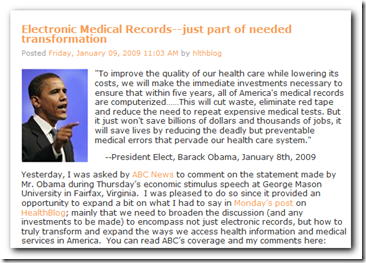This is a great article and good comments from Dr. Bill Crounse at Microsoft. from ABC News. If you read this blog often enough, you will find several posts relating back to his blog, as his posts are informative and he works hard at keeping interested readers up to date, not only here in the US, but he also shares  information from his travels and speaking engagements on what is happening outside the US.
information from his travels and speaking engagements on what is happening outside the US.
You can find his blog here, or under my Blog Roll Section on the page, and here’s a link to his post for today.
Last year I had the opportunity to talk with Dr. Crounse at HIMMS and we covered a lot of topics, and one thing of course we both have in common is that we are both avid Tablet PC fans, you will see quite a few posts on his blog relative to Tablets as well. At HIMMS there were a lot of tablet pcs being shown in various booths, but I used my unit to work the show, in other words with every booth I visited, I had a business intelligence file already set up in One Note so I could take notes in real time with all I visited with, Tablet PC, a great tool for working conventions. I was impressed as Dr. Crounse knew me as the “Medical Quack”, one huge compliment for me in knowing where this blog reaches at times.
HIMMS 2008 Summary - Getting organized is the trick
While at the show (with my tablet pc) I had an old demo version from Microsoft running on the tablet, and this was just before the public release on the Common User Interface project, and it drew a lot of attention. I still keep seeing this YouTube video I made still popping up occasionally on websites today. I even got a little carried away with doing a speech recognition demo on the floor, which of course was not perfect, but rather just showing another way of interacting with a computer for input of medical records.
Back to the discussion at hand with medical records, one other thoughts that I have too on the subject is that it is a very complicated situation today. As software algorithms continue to grow in complexity, so does the software, and that is everywhere we turn today. This is rapidly presenting a need for standards and simplicity of use for the healthcare industry. 
Cost of course is a big ticket today with the state of our economy and something that can’t be overlooked, but where software developers can join force is to create a simpler, yet dynamic method for clinicians to use. Code Plex is a portion of Microsoft that is free and donated open source code available to any developer to work with and within Code Plex there is what is called “A Common User Interface” that any software company can download and develop.
So what is so important about standards and a common user interface – let me put this bluntly, it’s called ease of use and functionality. Let’s take Dr. Smith who is on staff at 3 hospitals, each of them using a different medical records software system. Did I get your attention yet?
Well as we all complain about healthcare being so slow to adapt medical records, this one scores one big negativity factor for the doctors, does this doctor, who’s primary job is to take care of us, need to learn 3 different software systems, and how about the time it takes him. Ok, we all go through software updates everywhere we go today, but keep in mind all the information about each patient that is flowing today to a physician. It’s an administrative nightmare for the physician, no matter how you look at it and it’s no wonder the frustration and non-participation levels are high, put yourself in those shoes. I have done my own little survey in asking doctors how they would feel if the screens and data entry were all the same at any hospital they happen to be on staff at or have a working relationship, do you think any of them said “no” I wouldn’t like that, of course not. I think one would have to be a bit crazy to say I like having 3 different input screens to learn, agree?
So what we are talking about here is not only medical records, but a system that can work and have a familiar face at any facility. The Common User Interface, as being developed by the NHS is something that should not be overlooked as much of the work is already done! Do we really need to re-invent the wheel? It does make me somewhat wonder if software developers are trying to do just that when reading articles such as this one, wondering what is going on here, are they trying to start from scratch?
GE, Mayo Clinic, others to develop health record technology
I have a multitude of articles on the blog discussing the Common User Interface, again free for taking and developing to perhaps one day bring the same dynamic data entry screens and processes to every hospital and physician’s office across the US. Years ago I wrote a very simple EMR before the complexities of today and have followed the progress and am an active contributor and moderator on EMR Update, a site discussing electronic medical records. The physicians at EMR Update came to know me around there a few years ago and we have a great exchange of technical and clinical information where input from both sides can lead to solutions and you will also find this blog syndicated there as well.
Dr. Crounse on his blog also has a nice informative post about the Common User Interface with links to the MSDN technical pages. When you stop and think about it, the interface makes sense and I wonder where the delay is myself with developers who might not be taking a serious look at coming together to make the process easier, you have to think of the end user today with simplified software screens, otherwise it’s just another overloaded software system. Me, being a consultant too, just from my tiny corner of the word, how many software systems do I have to learn to be able to give support? I feel the same as the doctors on this one. (grin).
It just makes one wonder why perhaps we might not be a little more united in this effort to create a product that would have simplicity, dynamics, and something that would only require training on one interface, as the back end software could still function and query as usual. The related reading below references many of my past posts on the subject and even one on a small developer in New Zealand who doesn’t even write code with a Microsoft product, but is making use of the interface with his project.
In short, when it comes down to a system that will work, why don’t we all get together and take advantage of some valuable resources that are here today, built for the future and make it easier for the healthcare individuals we rely on to guide us to better healthcare?
In a related technology story, I found my post on Vanderbilt’s internal website, relating back to another solution for the instant detection of Sepsis, using Microsoft technology and the University is ready and willing to share with all. Dr, Crounse also has an in depth post on his blog that can be found here.
I also had a chance to talk with Hemang Patel from Microsoft’s mobility area of healthcare at HIMMS. You can view a couple videos here on Dr. Crouse's blog that have been posted in the past about healthcare as related to cell phone platforms.
One more item worth mentioning too is the availability of Microsoft Technical Centers, 16 locations where you can get free architecture help and get software up and running much faster. Facilities as such might be able to help with programming of the Common User Interface too. I have been to the facility in Irvine, and the link above mentions many of the local Irvine employees of Microsoft that I have the opportunity to learn from and interact with. You get to see some very exciting technology too, see the link below about Microsoft Surface.
Hospital Operator Demos Health Care Application For Microsoft Surface
And more item worth a short note, I was able to fold DNA protein on Surface while there one day for a meeting. I mentioned this with my interview this week with Rosetta Genomics and he was very interested as well in how this could be done, as they work with microRNAs.
Long and short of all of this is that hopefully the Obama team will investigate and maybe find that most of the answers being sought out for solutions are already here, they just need to be instituted with a CTO that can get the job done for us and last but not least, we do have a couple good personal health records solutions that are there and available for consumers today. My blog has many posts over the last year as well as permanent links for anyone to get started.
The solutions are there for integration and technology today, standards and perhaps unifying our efforts to become less fractured will be the answer and again, I hope the Obama team is doing their homework here, and in time we will have a better idea of the direction we are heading without having to take time to re-invent the wheel. BD
In the latest step toward the computerization of Americans' medical information, President-elect Barack Obama said in a speech Thursday that the government will push for electronic health records for all Americans within five years in order to save both dollars and lives.
Dr. Bill Crounse, senior director of worldwide health for the Microsoft Corporation, said that he is "thrilled that President-elect Barack Obama is stepping forward to carry the torch" with regard to the development of electronic medical records for all Americans.
"The opportunity here is so much bigger than just electronic medical records," he said. "The opportunity is really to think in entirely new ways about how you do health care."
Microsoft could well be one of the major players in the eventual development of such a system. The company launched a beta program of
an online medical records program called Healthvault in 2007. The company now has partnered with Kaiser, the American Heart Association, the Cleveland Clinic and others in creating a user-accessible program and laying an infrastructure for others to build upon.
Crounse said that it is little surprise that few doctors -- particularly primary care doctors -- are stepping forward to invest what he says could be $25,000 in a system for electronic medical records.
"We're asking them to step up and spend a lot of money on electronic medical records. The doctors will say that a lot of the benefits of these systems accrue to everyone but the doctor."
While he said that the benefits for doctors are there -- primarily in the form of improved patient safety and care -- this perception could give many doctors pause.
Ideally, Crounse and Robb both noted, these records would let patients manage their medical particulars in much the same way as they manage their financial matters online.
And Webb added that considering the current state of the country's health-care system, the time is ripe for change -- and government finds toward this effort would be money well spent.
ABC News: President-Elect Urges Electronic Medical Records in 5 Years
Related Reading:







0 comments :
Post a Comment